MLA文献条目的著录格式及示例摘要
m’la 格式参考文献模板

m’la 格式参考文献模板
MLA(Modern Language Association)格式是文学类论文常用的引用格式。
以下是MLA格式的参考文献模板:
一、书籍引用
1. 独著
姓,名. 书名. 出版地:出版社,出版年代.
例如:
Bambrugh, R. The Philosphy of Aristotle. New York: Free Press, 1962.
2. 合著
姓,名,同另一姓,名. 书名. 出版地:出版社,出版年代.
例如:
Gass, W., and P. Hendrix. The American Language. New York: Harcourt Brace Jovanovich, 1977.
二、期刊文章引用
1. 一位作者写的文章
姓,名. "文章标题." 期刊名,卷号(年份),页码.
例如:
Stewart, D. "What is an English Major, and What Should It Be?" College English, 50 (1988), .
2. 多位作者写的文章
第一作者的姓,名,同第二作者的姓,名等."文章标题." 期刊名,卷号(年份),页码.
例如:
Johnson, R., and E. Smith. "The State of the Disciplines." English Journal, 88 (1998), 41-48.
请注意,在MLA格式中,使用完整句子形式在论文中出现引用观点的地方写出参考文献。
同时,务必确定老师要求的格式版本。
mla中文参考文献格式

mla中文参考文献格式MLA格式是一种常用的学术论文引用格式,适用于人文学科的研究论文。
以下是MLA中文参考文献格式的写作要求和一些相关参考内容:一、书籍的引用格式:作者姓,名。
题名。
出版地:出版社,出版年。
印刷。
例如:王小波。
黄金时代。
北京:北京十月文艺出版社,2007。
印刷。
二、诗歌或短篇小说的引用格式:作者姓,名。
"诗歌或短篇小说标题." 集合名,编辑姓,名。
出版地:出版社,出版年。
印刷。
例如:余光中。
"乡愁"。
闻一多诗选,李镜莲编。
北京:人民文学出版社,1986。
印刷。
三、期刊文章的引用格式:作者姓,名。
"文章标题." 期刊名,卷号.号码(年):页码。
例如:李天命。
"诗与心灵的飨宴." 中国文学研究,第30卷第4期(2005):94-98。
四、网页的引用格式:作者(如果有的话)。
"文章标题." 网站标题(斜体),出版日期(如果有的话)。
例如:李白。
"静夜思." 古诗文网(斜体),2009年。
五、电影的引用格式:电影名。
导演名。
演员名。
出品公司,年份。
例如:《活着》。
张艺谋。
葛优,巩俐。
北京新亚洲影视传媒有限公司,1994。
以上是MLA中文参考文献格式的一些常见写作要求和示例。
写作时需要依据提供的信息填写相应的内容,确保格式正确。
另外,还需要注意参考文献列表末尾的字母排序和缩进等细节。
建议在参考文献的写作过程中参考MLA手册或询问导师或咨询学术写作中心,以确保准确无误。
MLA 格式论文范文
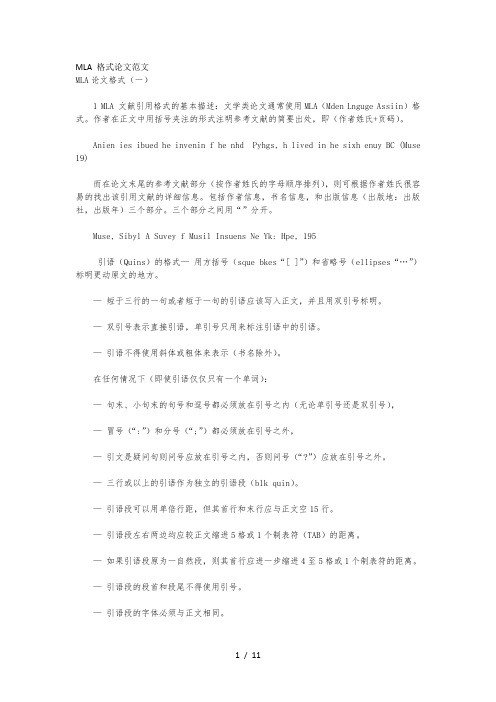
MLA 格式论文范文MLA论文格式(一)1 MLA 文献引用格式的基本描述:文学类论文通常使用MLA(Mden Lnguge Assiin)格式。
作者在正文中用括号夹注的形式注明参考文献的简要出处,即(作者姓氏+页码)。
Anien ies ibued he invenin f he nhd Pyhgs, h lived in he sixh enuy BC (Muse 19)而在论文末尾的参考文献部分(按作者姓氏的字母顺序排列),则可根据作者姓氏很容易的找出该引用文献的详细信息。
包括作者信息,书名信息,和出版信息(出版地:出版社,出版年)三个部分。
三个部分之间用“”分开。
Muse, Sibyl A Suvey f Musil Insuens Ne Yk: Hpe, 195引语(Quins)的格式—用方括号(sque bkes“[ ]”)和省略号(ellipses“…”)标明更动原文的地方。
—短于三行的一句或者短于一句的引语应该写入正文,并且用双引号标明。
—双引号表示直接引语,单引号只用来标注引语中的引语。
—引语不得使用斜体或粗体来表示(书名除外)。
在任何情况下(即使引语仅仅只有一个单词):—句末、小句末的句号和逗号都必须放在引号之内(无论单引号还是双引号),—冒号(“:”)和分号(“;”)都必须放在引号之外,—引文是疑问句则问号应放在引号之内,否则问号(“?”)应放在引号之外。
—三行或以上的引语作为独立的引语段(blk quin)。
—引语段可以用单倍行距,但其首行和末行应与正文空15行。
—引语段左右两边均应较正文缩进5格或1个制表符(TAB)的距离。
—如果引语段原为一自然段,则其首行应进一步缩进4至5格或1个制表符的距离。
—引语段的段首和段尾不得使用引号。
—引语段的字体必须与正文相同。
3.夹注(Penheil Ciin)的格式:引文出处使用括号夹注的方法(一般不使用脚注或者尾注)。
正文中,括号夹注(作者姓氏+页码)放在句末标点以内,但不得放在引文的引号以内。
MLA 格式论文范文
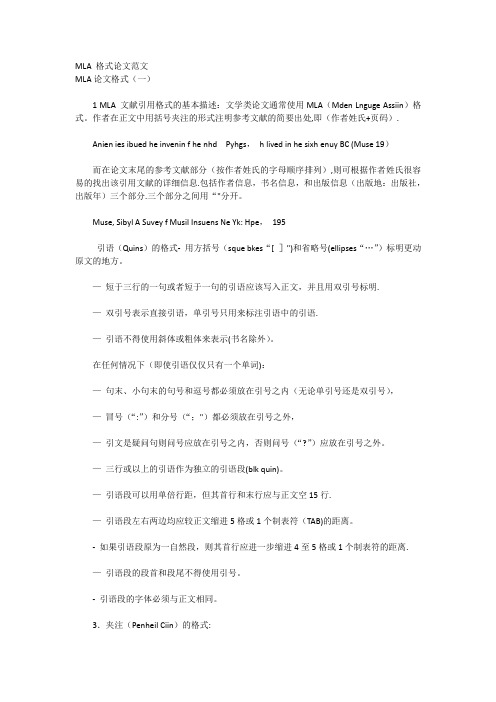
MLA 格式论文范文MLA论文格式(一)1 MLA 文献引用格式的基本描述:文学类论文通常使用MLA(Mden Lnguge Assiin)格式。
作者在正文中用括号夹注的形式注明参考文献的简要出处,即(作者姓氏+页码).Anien ies ibued he invenin f he nhd Pyhgs,h lived in he sixh enuy BC (Muse 19)而在论文末尾的参考文献部分(按作者姓氏的字母顺序排列),则可根据作者姓氏很容易的找出该引用文献的详细信息.包括作者信息,书名信息,和出版信息(出版地:出版社,出版年)三个部分.三个部分之间用“"分开。
Muse, Sibyl A Suvey f Musil Insuens Ne Yk: Hpe,195引语(Quins)的格式- 用方括号(sque bkes“[ ]")和省略号(ellipses“…”)标明更动原文的地方。
—短于三行的一句或者短于一句的引语应该写入正文,并且用双引号标明.—双引号表示直接引语,单引号只用来标注引语中的引语.—引语不得使用斜体或粗体来表示(书名除外)。
在任何情况下(即使引语仅仅只有一个单词):—句末、小句末的句号和逗号都必须放在引号之内(无论单引号还是双引号),—冒号(“:”)和分号(“;")都必须放在引号之外,—引文是疑问句则问号应放在引号之内,否则问号(“?”)应放在引号之外。
—三行或以上的引语作为独立的引语段(blk quin)。
—引语段可以用单倍行距,但其首行和末行应与正文空15行.—引语段左右两边均应较正文缩进5格或1个制表符(TAB)的距离。
- 如果引语段原为一自然段,则其首行应进一步缩进4至5格或1个制表符的距离.—引语段的段首和段尾不得使用引号。
- 引语段的字体必须与正文相同。
3.夹注(Penheil Ciin)的格式:引文出处使用括号夹注的方法(一般不使用脚注或者尾注)。
5种MLA参考文献引用格式解析

5种MLA参考文献引用格式解析M L A作为美国现代语言协会指定的一种论文指导格式,是在论文写作中比较常见的一种格式,然而很多留学新生对M L A引用格式只有一知半解,可能一不小心就会用错。
要想避免这种情况发生,那么大家需要学会使用M L A参考文献引用,下面就给大家讲解一下。
1MLA的基本格式一般情况下,M L A的基本引用格式需要在括号中写入所引用作者的姓氏以及页码。
如:(H a w k i n s201)以此来表示我们在文中引用的内容是来自H a w k i n s某部作品的第201页。
如果我们在文中已经提到了作者的姓名,则只需要在引文后的括号中标注出页码即可。
这种情况下是不需要再次对作者的姓名进行重申的。
2多作者引用的格式当我们遇到同一个引用有两位作者时,我们只需要在两位的姓氏中间用a n d进行连接,如:(H a w k i n s a n d S c h r e i b e r201),这里则表示我们所引用的内容是来自于H a w k i n s和S c h r e i b e r两位作者同时编译的某部作品的第201页,同理,若文中已经提及了两位作者的姓名,那么我们是不需要再进行二次重申的,只需要在引文后的括号中标注出页码即可。
除此之外,如果我们遇到了超过两位以上作者的同一个引用又该如何处理呢?这个时候我们只需要在引文中写入第一位作者即可,但是一定要在第一位作者后紧跟“e t a l.”这里的“e t a l.”是用来表示除了该作者之外还有其他的作者姓名没有进行列出。
3姓氏相同的多作者引用格式当我们在文中引用的几位作者恰好姓氏相同时,在M L A的格式中,我们需要给出作者名字的首字母来进行区别,如:(A.S m i t h32)和(Z.S m i t h91)。
在此需要注意的是,在引用作品的列表中,我们是需要提供所有作者的完整姓氏以及名字的,是不能进行简写的。
4多作品的引用如果同一位作者的多部作品被同时引用了,那么在M L A格式中是需要在标注中使用原作品的标题来进行区别,此时是不可以用出版年份来区别的。
mla参考文献引用格式
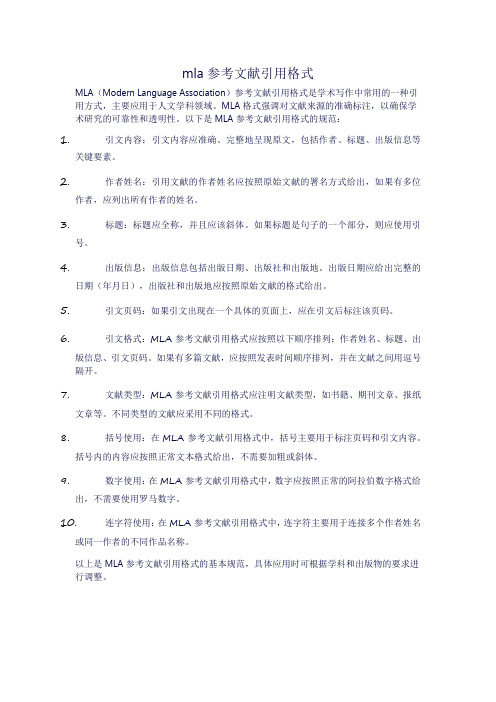
mla参考文献引用格式MLA(Modern Language Association)参考文献引用格式是学术写作中常用的一种引用方式,主要应用于人文学科领域。
MLA格式强调对文献来源的准确标注,以确保学术研究的可靠性和透明性。
以下是MLA参考文献引用格式的规范:1.引文内容:引文内容应准确、完整地呈现原文,包括作者、标题、出版信息等关键要素。
2.作者姓名:引用文献的作者姓名应按照原始文献的署名方式给出,如果有多位作者,应列出所有作者的姓名。
3.标题:标题应全称,并且应该斜体。
如果标题是句子的一个部分,则应使用引号。
4.出版信息:出版信息包括出版日期、出版社和出版地。
出版日期应给出完整的日期(年月日),出版社和出版地应按照原始文献的格式给出。
5.引文页码:如果引文出现在一个具体的页面上,应在引文后标注该页码。
6.引文格式:MLA参考文献引用格式应按照以下顺序排列:作者姓名、标题、出版信息、引文页码。
如果有多篇文献,应按照发表时间顺序排列,并在文献之间用逗号隔开。
7.文献类型:MLA参考文献引用格式应注明文献类型,如书籍、期刊文章、报纸文章等。
不同类型的文献应采用不同的格式。
8.括号使用:在MLA参考文献引用格式中,括号主要用于标注页码和引文内容。
括号内的内容应按照正常文本格式给出,不需要加粗或斜体。
9.数字使用:在MLA参考文献引用格式中,数字应按照正常的阿拉伯数字格式给出,不需要使用罗马数字。
10.连字符使用:在MLA参考文献引用格式中,连字符主要用于连接多个作者姓名或同一作者的不同作品名称。
以上是MLA参考文献引用格式的基本规范,具体应用时可根据学科和出版物的要求进行调整。
MLA格式说明(5篇)
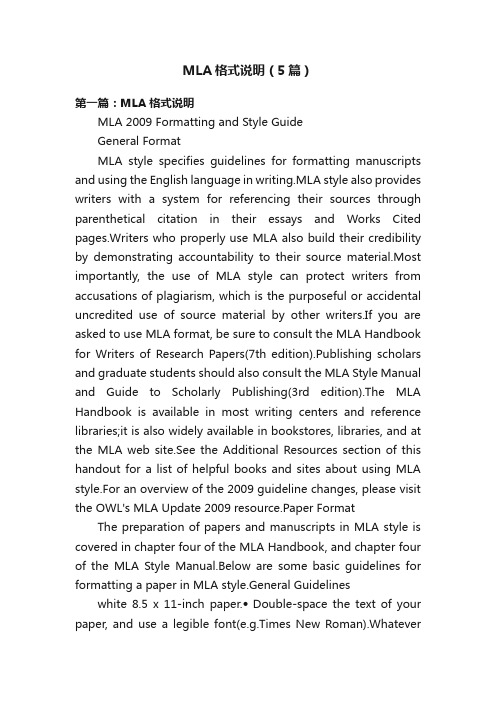
MLA格式说明(5篇)第一篇:MLA格式说明MLA 2009 Formatting and Style GuideGeneral FormatMLA style specifies guidelines for formatting manuscripts and using the English language in writing.MLA style also provides writers with a system for referencing their sources through parenthetical citation in their essays and Works Cited pages.Writers who properly use MLA also build their credibility by demonstrating accountability to their source material.Most importantly, the use of MLA style can protect writers from accusations of plagiarism, which is the purposeful or accidental uncredited use of source material by other writers.If you are asked to use MLA format, be sure to consult the MLA Handbook for Writers of Research Papers(7th edition).Publishing scholars and graduate students should also consult the MLA Style Manual and Guide to Scholarly Publishing(3rd edition).The MLA Handbook is available in most writing centers and reference libraries;it is also widely available in bookstores, libraries, and at the MLA web site.See the Additional Resources section of this handout for a list of helpful books and sites about using MLA style.For an overview of the 2009 guideline changes, please visit the OWL's MLA Update 2009 resource.Paper FormatThe preparation of papers and manuscripts in MLA style is covered in chapter four of the MLA Handbook, and chapter four of the MLA Style Manual.Below are some basic guidelines for formatting a paper in MLA style.General Guidelineswhite 8.5 x 11-inch paper.•Double-space the text of your paper, and use a legible font(e.g.Times New Roman).Whateverfont you choose, MLA recommends that the regular and italics type styles contrast enough that they are recognizable one from another.The font size should be 12 pt.• Leave only one space after periods or other punctuation marks(unless otherwise instructed by your instructor).• Set the margins of your document to 1 inch on all sides.• Indent the first line of paragraphs one half-inch from the left margin.MLA recommends that you use the T ab key as opposed to pushing the Space Bar five times.• Create a header that numbers all pages consecutively in the upper right-hand corner, one-half inch from the top and flush with the right margin.(Note: Your instructor may ask that you omit the number on your first page.Always follow your instructor's guidelines.) •Use italics throughout your essay for the titles of longer works and, only when absolutely necessary, providing emphasis.•Type your paper on a computer and print it out on standard,before your Works Cited page.Entitle the section Notes(centered, unformatted).Formatting the First Page of Your Paper • If you have any endnotes, include them on a separate pageDo not make a title page for your paper unless specifically requested.your instructor's name, the course, and the date.Again, be sure to use double-spaced text.•Double space again and center the title.Do not underline, italicize, or place your title in quotation marks;write the title in Title Case(standard capitalization), not in all capital letters.•Use quotation marks and/or italics when referring to other works in your title, just as you would in your text: Fear and Loathing in Las Vegas as Morality Play;Human Weariness in “After Apple Picking”•Double space between the title and the first line of the text.•Create a header in the upper right-hand corner thatincludes your last name, followed by a space with a page number;number all pages consecutively with Arabic numerals(1, 2, 3, 4, etc.), one-half inch from the top and flush with the right margin.(Note: Your instructor or other readers may ask that you omit last name/page number header on your first page.Always follow instructor guidelines.)Here is a sample of the top half of a first page in MLA style: A sample first page of an MLA-formatted paper.Section HeadingsWriters sometimes use Section Headings to improve a document’s readability.These sections may include individual chapters or other named parts of a book or essay.Essays MLA recommends that when you divide an essay into sections that you number those sections with an arabic number and a period followed by a space and the section name.1.Early Writings 2.The London Years 3.Traveling the Continent 4.Final YearsBooksMLA does not have a prescribed system of headings for books.If you are only using one level of headings, meaning that all of the sections are distinct and parallel and have no additional sections that fit within them, MLA recommends that these sections resemble• In the upper left-hand corner of the first page, list your name,one another grammatically.For instance, if your headings are typically short phrases, make all of the headings short phrases(and not, for example, full sentences).Otherwise, the formatting is up to you.It should, however, be consistent throughout the document.If you employ multiple levels of headings(some of your sections have sections within sections), you may want to provide a key of your chosen level headings and their formatting to your instructor or editor.Sample SectionHeadingsThe following sample headings are meant to be used only as a reference.You may employ whatever system of formatting that works best for you so long as it remains consistent throughout the document.Numbered:1.Soil Conservation 1.1 Erosion 1.2 Terracing2.Water Conservation3.Energy ConservationFormatted, unnumbered:Level 1 Heading: bold, flush leftLevel 2 Heading: italics, flush leftLevel 3 Heading: centered, boldLevel 4 Heading: centered, italics How to Cite the Purdue OWL in MLA:Entire WebsiteThe Purdue OWL.Purdue U Writing Lab, 2008.Web.27 Dec.2008.Individual ResourcesPurdue OWL.“MLA Formatting and Style Guide.” The Purdue OWL.Purdue U Writing Lab, 10 May 2008.Web.15 Nov.2008.All Sections in MLA 2009 Formatting and Style Guide:1.MLA 2009 Formatting and Style Guide2.MLA 2009 In-Text Citations: The Basics3.MLA 2009 Formatting Quotations4.MLA 2009 Footnotes and Endnotes5.MLA 2009 Works Cited Page: Basic Format6.MLA 2009 Works Cited Page: Books7.MLA 2009 Works Cited: Periodicals8.MLA 2009 Works Cited: Electronic Sources(Web Publications)9.MLA 2009 Works Cited: Other Common Sources10.MLA 2009 Additional Resources11.MLA 2009 Abbreviations12.MLA 2009 Sample Works Cited Page13.MLA 2009 Sample Papers14.MLA 2009 Tables, Figures, and Examples15.MLA 2009 PowerPoint Presentation16.MLA 2009Undergraduate Sample Paper第二篇:MLA格式Hua SuPolitical Science 101, Section009Professor Dighton M.FiddnerMarch 2010Brief Analysis of Cuban Missile CrisisI think the people who have at least a little bit concern about the world issues should know the famous Cuban Missile Crisis.It has being discussed and studied over and over again by many scientists, scholars and experts since it happened.On October 15, 1962, United States reconnaissance discovered and had photos to prove that there were missile bases being built in Cuba.“One of the most startling of the thousands of photographs---some 30,000 feet of film in all---analyzed by the President and his advisers is this one of a fully operating medium-range missile base, manned by Russian technicians and able to shoot its missiles as far into the U.S.as Norfolk or Houston “(The Pictures That Spurred Us to Act)”.The next day, the president of United States was informed and organized a group of advisors, which is called Executive Committee of the National Security Council, short for EXCOMM, to discuss how to deal with this perilous event.In Cuba at that time, the government was led by communist Fidel Castro.He was afraid that the United States would attack Cuba again after the failure of the Bay of Pigs invasion.So he agreed that Soviet Union, which was led by Nikita Khrushchev at that time, could put missiles in Cuba.Because Cuba and United States are so close to each other, the missiles in Cuba werebig threat to US.After several days of discussion, the government of Kennedy imposed a naval quarantine aroundCuba and demanded that the Soviet Union removed the missiles from Cuba.After a series of negotiations between the United States, Soviet Union and Cuba, on October 28, 1962, the crisis eased after a no-invasion agreement was reached and the Soviet Union agreed to dismantle the missiles.I think it will be best for me to explain this significant event using the interstate level of analysis and the theory of realism.Interstate level of analysis contains several categories which influence the Cuban missile crisis obviously.Power is the most apparent influence.Just like Cuban, Soviet and United States all competed and threatened each other with their military power.And between Cuba and Soviet Union, they formed an alliance against United States.During the crisis, IGOs, summit meetings, each side’s diplomacy and the bargaining happening among their negotiations all had important influences which should not be forgotten.Power is the ability to get someone to do what it would not otherwise have done(or not to do what it would have done)(Goldstein et al.).United States at that time could not stand that there is a communist country located so close to it.So a CIA trained force tried to overthrow the government of Fidel Castro on April 17, 1961.But it turned out a failure.After the Bay of Pigs invasion, Cuba found out that only by increasing its own power can it prevent another United States’ invasion.And, improvement of its military power is the best way.At that time, the biggest andstrongest communist country was Soviet Union.It possessed nuclear weapons.That was also the time when the United States and the Soviet Union were the major participants of the Cold War.They competed with each other in the fields of politics, military, economy, etc.Cuba is located only several miles awayfrom Florida.So, it would be a great threat to the United States by placing nuclear missiles on the island of Cuba and at the same time prevent the United States from starting another invasion of Cuba.Cuba agreed the nuclear missiles building is for the sake of its sovereignty, territory and organization of governing.As for the Soviet Union, the reason is its diplomatic recognition.They all did it for their own interests.During the event, in order to prevent the Soviet Union from shipping more nuclear missiles devices to Cuba, the United States blocked the sea around the island of Cuba.But, the United States actually had no right to do the quarantine.United States’ quarantine against Cuba, in my opinion, was realism.Every nation has its right to possess its weapon for defense.It is against the international law, the United Nation’s Charter and the right of passage in international wate rs.The United States’ action had implied that there is no central organizing authority in the international politics.Every entity seeks its self-interests.The United States has reported that the nuclear missiles which were being placed in Cuba were seriously offensive(The Pictures That Spurred Us to Act).So in order to keep its national security under control, the United States chose to use quarantine.And this quarantine greatly related to the power of the United States.It had strong economic and military power so that this restrict quarantine can be forced.The United Nations had noticed the possibility that the conflict between these two super powers could lead to a nuclear war which would be a huge disaster.So the United Nations was negotiating with these three nations trying to ease the tension.“The break in the crisis came on Sunday, October 28, when the Soviet Government finally agreed to dismantle its offensive weapons in Cuba and return them to the Soviet Unionsubject to United Nations’ verification”().When the United States, the Soviet Union and Cuba were negotiating with each other, there was a lot of bargaining going on between them.There were a lot of letters and communications being exchanged between Khrushchev and Kennedy:On October 23 and 24, Khrushchev sent letters to Kennedy indicatingthe deterrent nature of the missiles in Cuba and the peaceful intentions ofthe Soviet Union.On October 26, Khrushchev sent Kennedy a longrambling letter seemingly proposing that the missile installations wouldbe dismantled and personnel removed in exchange for United Statesassurances that it or its proxies would not invade Cuba.On October 27,another letter to Kennedy arrived from Khrushchev, suggesting thatmissile installations in Cuba would be dismantled if the United Statesdismantled its missile installations in Turkey(Cold War: Cuban MissileCrisis).However the United States did agree the Soviet Union to remove the Jupiter missiles in Turkey.Just at that time this agreement didn’t go public.At the same time, the United States agreed to sign an agreement that promised not to invade Cuba.Sowe can tell from the information that the Soviet Union and the United States both were bargaining about their preferredoutcomes.And the Soviet Union had achieved its two main goals.Asking the United States to remove the Jupiter missile in Turkey was for the sake of its national security;and forming an agreement which the United States would not invade Cuba was for its diplomatic recognition.Because at that time, the world media did not report the news that the United States had already agreed to remove the Jupiter missile in Turkey and, which was very obvious that the Soviet Union had already removed its missile in Cuba.In public, it seemed that the Soviet Union lost and the United States won.However in reality, they both made concessions.I basically used the theory of realism and the interstate level of analysis to explain my point of view toward this event.And I pointed out a couple of key influences of the Cuban missile crisis, like the theory of power, UN’s interference, bargaining, summit meeting etc.In my point of view, these are the major factors I should think of when it comes to analyze the Cuban missile crisis.This Cuban missile crisis makes the world realize that how close we are to a nuclear war and how important the non-proliferation of nuclear weapons is for the people around the world.We cannot afford the price of starting WWIII.So the best way to avoid it is to know, learn and study the possible causes and try to predict the outcome of complicated international event.Works Cited“The Pictures That Spurred Us to Act).” Life(1962): 38-41.Print.Goldstein, Joshua S., and Jon C.Pevehouse.“Power.” International Relations.7th ed.Priscilla McGeehon, 2006.57-58.Print.“Cuban Missile Crisis.” .Web.20 Mar.2010.“Cold War: Cuban Missile Crisis.” Library of Congress.Web.20 Mar.2010.“Vienna Summit.” Wikipedia, the Free Encyclopedia.Web.20 Mar.2010.第三篇:英文注释MLA和APA格式Modern Language Association为美国现代语言协会制定的论文指导格式,在一般书写英语论文时应当使用MLA格式来保证学术著作的完整。
MLA 正文引用+参考文献
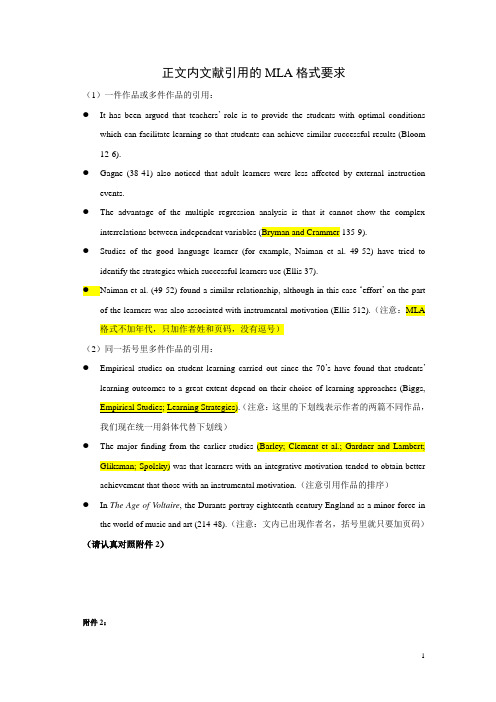
正文内文献引用的MLA格式要求(1)一件作品或多件作品的引用:●It has been argued that teachers’role is to provide the students with optimal conditionswhich can facilitate learning so that students can achieve similar successful results (Bloom 12-6).●Gagne (38-41) also noticed that adult learners were less affected by external instructionevents.●The advantage of the multiple regression analysis is that it cannot show the complexinterrelations between independent variables (Bryman and Crammer 135-9).●Studies of the good language learner (for example, Naiman et al. 49-52) have tried toidentify the strategies which successful learners use (Ellis 37).●Naiman et al. (49-52) found a similar relationship, although in this case ‘effort’ on the partof the learners was also associated with instrumental motivation (Ellis 512).(注意:MLA 格式不加年代,只加作者姓和页码,没有逗号)(2)同一括号里多件作品的引用:●Empirical studies on student learning carried out since the 70’s have found that students’learning outcomes to a great extent depend on their choice of learning approaches (Biggs,注意:这里的下划线表示作者的两篇不同作品,我们现在统一用斜体代替下划线)●The major finding from the earlier studies (Barley; Clement et al.; Gardner and Lambert;Gliksman; Spolsky) was that learners with an integrative motivation tended to obtain better achievement that those with an instrumental motivation.(注意引用作品的排序)●In The Age of Voltaire, the Durants portray eighteenth century England as a minor force inthe world of music and art (214-48).(注意:文内已出现作者名,括号里就只要加页码)(请认真对照附件2)附件2:参考文献MLA格式要求●按先英文后中文排序;●字号比正文小一号打印;标点统一用半角状态;标点后统一空一格(汉语文献与英语文献类同,见下面示例);●悬挂缩进;●书目格式按MLA格式排列。
2b.本科学位论文MLA格式的基本结构、引用文献和参考书目格式
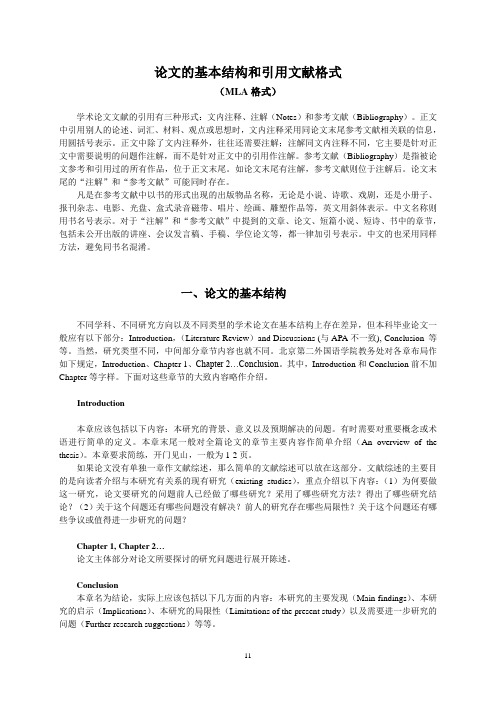
论文的基本结构和引用文献格式(MLA格式)学术论文文献的引用有三种形式:文内注释、注解(Notes)和参考文献(Bibliography)。
正文中引用别人的论述、词汇、材料、观点或思想时,文内注释采用同论文末尾参考文献相关联的信息,用圆括号表示。
正文中除了文内注释外,往往还需要注解;注解同文内注释不同,它主要是针对正文中需要说明的问题作注解,而不是针对正文中的引用作注解。
参考文献(Bibliography)是指被论文参考和引用过的所有作品,位于正文末尾。
如论文末尾有注解,参考文献则位于注解后。
论文末尾的“注解”和“参考文献”可能同时存在。
凡是在参考文献中以书的形式出现的出版物品名称,无论是小说、诗歌、戏剧,还是小册子、报刊杂志、电影、光盘、盒式录音磁带、唱片、绘画、雕塑作品等,英文用斜体表示。
中文名称则用书名号表示。
对于“注解”和“参考文献”中提到的文章、论文、短篇小说、短诗、书中的章节,包括未公开出版的讲座、会议发言稿、手稿、学位论文等,都一律加引号表示。
中文的也采用同样方法,避免同书名混淆。
一、论文的基本结构不同学科、不同研究方向以及不同类型的学术论文在基本结构上存在差异,但本科毕业论文一般应有以下部分:Introduction,(Literature Review)and Discussions (与APA不一致), Conclusion 等等。
当然,研究类型不同,中间部分章节内容也就不同。
北京第二外国语学院教务处对各章布局作如下规定,Introduction、Chapter 1、Chapter 2…Conclusion。
其中,Introduction和Conclusion前不加Chapter等字样。
下面对这些章节的大致内容略作介绍。
Introduction本章应该包括以下内容:本研究的背景、意义以及预期解决的问题。
有时需要对重要概念或术语进行简单的定义。
本章末尾一般对全篇论文的章节主要内容作简单介绍(An overview of the thesis)。
中文文献MLA格式说明_2010

中文文献MLA格式说明_2010一、MLA 格式的一般要求MLA 格式通常要求使用双倍行距,页边距为 1 英寸(约 254 厘米)。
字体一般使用 12 号的 Times New Roman 字体。
在页面的上方,需依次写上您的姓名、教授的姓名、课程名称以及日期,这些信息左对齐。
二、中文文献引用的基本元素对于中文文献的引用,主要包含以下几个基本元素:作者、文献标题、出版信息、页码等。
作者:如果作者是个人,按照姓在前,名在后的顺序书写,名缩写为首字母。
如果有多个作者,用逗号分隔,最后两个作者之间用“and”连接。
文献标题:中文文献标题使用书名号《》括起来。
出版信息:包括出版地、出版社和出版年份。
页码:如果引用的内容有具体的页码,需要在引用处注明。
三、中文书籍的引用引用一本中文书籍时,格式如下:姓,名《书名》出版地:出版社,出版年份例如:王小明《中国古代文学简史》北京:人民出版社,2010、如果引用的书籍有多个作者,格式为:姓 1,名 1,姓 2,名 2,and 姓 3,名 3、《书名》出版地:出版社,出版年份例如:李华,张华,and 王强《中国现代诗歌研究》上海:上海文艺出版社,2010、四、中文期刊文章的引用引用中文期刊文章时,格式如下:作者“文章标题” 《期刊名》卷号,期号(出版年份):页码例如:张三“论中国传统文化的传承与发展” 《文化研究》 5,2 (2010):25-30、五、中文报纸文章的引用对于中文报纸文章,引用格式为:作者“文章标题” 《报纸名》出版日期,版次例如:李四“城市绿化的新进展” 《光明日报》 2010 年 5 月 10 日,第 3 版六、中文网页的引用引用中文网页时,格式如下:作者“文章标题” 网站名发布日期网页链接例如:王五“中国经济增长的新趋势” 新浪网 2010 年 8 月 15 日七、中文论文集的引用如果引用的是中文论文集中的一篇文章,格式为:作者“文章标题” 见:论文集编者姓名《论文集名称》出版地:出版社,出版年份:页码例如:赵六“中国教育改革的思考” 见:陈七主编《教育发展研究》广州:广东教育出版社,2010:100-105、八、中文翻译作品的引用对于中文翻译作品,格式如下:原作者书名(译者姓名,译)出版地:出版社,出版年份例如:美约翰·史密斯《美国历史》(李明,译)北京:商务印书馆,2010、九、注意事项1、在引用中文文献时,要确保作者姓名、书名、期刊名等的翻译准确无误。
mla格式 引用

mla格式引用【实用版】目录1.MLA 格式概述2.MLA 格式的引用规则3.MLA 格式的引用示例正文一、MLA 格式概述MLA(Modern Language Association)格式是一种广泛应用于文学、语言学等领域的论文写作格式。
该格式主要体现在引用和参考文献的呈现方式上,以确保文献的可追溯性和学术诚信。
MLA 格式的引用特点是使用斜体字和括号,同时注明作者、出版年份和页码信息。
二、MLA 格式的引用规则1.引用文献时,将作者的姓氏和出版年份放在括号内,紧跟在引文之后。
例如:“根据李明(2021)的研究,我们可以得知……”2.如果引用同一作者的多篇文献,可以使用“ibid”表示同一出处,也可使用“op.cit.”表示已引用过的文献。
例如:“根据李明(2021,25-26)的研究,我们可以得知……”3.如果引用的文献有多个作者,请在括号内列出所有作者的姓氏,并用逗号分隔。
例如:“根据张三、李四和王五(2021)的研究,我们可以得知……”4.如果引用的文献没有作者,请在括号内注明出版年份和标题。
例如:“根据《中国古代文学史》(2020),我们可以得知……”三、MLA 格式的引用示例1.书籍引用示例:- 直接引用:根据张三(2021,123)的研究,我们可以得知……- 引用多个作者:根据张三、李四和王五(2021,25-26)的研究,我们可以得知……- 引用无作者书籍:根据《中国古代文学史》(2020),我们可以得知……2.文章引用示例:- 直接引用:根据李明(2021)的研究,我们可以得知……- 引用同一作者的多篇文献:根据李明(2021,25-26)的研究,我们可以得知……- 引用多个作者的文章:根据张三、李四和王五(2021)的研究,我们可以得知……3.网络资源引用示例:- 直接引用:根据王五(2021)的研究,我们可以得知……- 引用同一作者的多篇网络资源:根据王五(2021a)的研究,我们可以得知……通过遵循 MLA 格式的引用规则,我们可以确保论文的引用部分规范、严谨,从而提高论文的质量。
mla著作格式

mla著作格式
MLA(Modern Language Association)的著作格式通常包括以下部分:
1.标题页:包含书名、作者名、出版日期、出版社等基本信息。
2.目录:列出书中的主要章节、小节标题以及相应的页码。
3.正文:这是书的主要内容,包括各章节的内容和注释。
4.参考文献:列出在书中引用的所有文献,包括书籍、期刊文章、
报纸文章等。
在MLA的格式中,参考文献的引用方式通常采用作者-日期法,即先列出作者的名字,然后是出版日期。
例如:
作者名(出版年份):“文章标题”,出版地:出版社,第几版,页码。
以上信息仅供参考,具体格式可能会因不同的学科领域和学校要求而有所变化。
参考文献中MLA格式规范
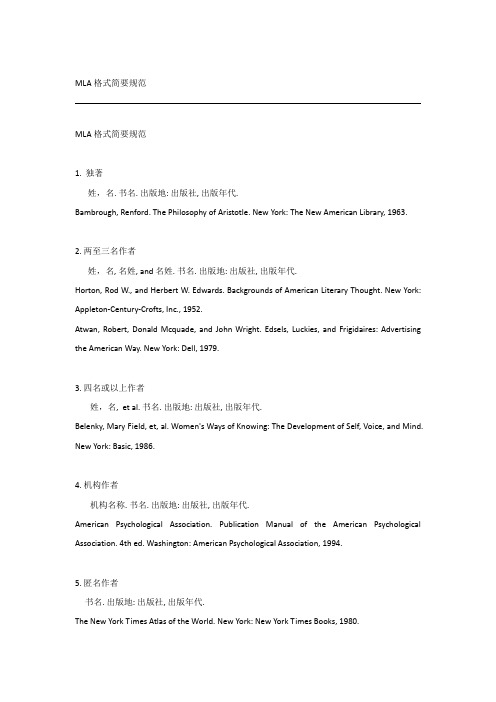
MLA格式简要规范MLA格式简要规范1. 独著姓,名. 书名. 出版地: 出版社, 出版年代.Bambrough, Renford. The Philosophy of Aristotle. New York: The New American Library, 1963.2. 两至三名作者姓,名, 名姓, and 名姓. 书名. 出版地: 出版社, 出版年代.Horton, Rod W., and Herbert W. Edwards. Backgrounds of American Literary Thought. New York: Appleton-Century-Crofts, Inc., 1952.Atwan, Robert, Donald Mcquade, and John Wright. Edsels, Luckies, and Frigidaires: Advertising the American Way. New York: Dell, 1979.3. 四名或以上作者姓,名, et al. 书名. 出版地: 出版社, 出版年代.Belenky, Mary Field, et, al. Women's Ways of Knowing: The Development of Self, Voice, and Mind. New York: Basic, 1986.4. 机构作者机构名称. 书名. 出版地: 出版社, 出版年代.American Psychological Association. Publication Manual of the American Psychological Association. 4th ed. Washington: American Psychological Association, 1994.5. 匿名作者书名. 出版地: 出版社, 出版年代.The New York Times Atlas of the World. New York: New York Times Books, 1980.6. 同一作者两本以上著作以书名第一个主要单词的首字母顺序排列先后,作者的姓名放在第一条文献条目前,第二条文献条目前用三个连字号。
mla格式的参考文献格式
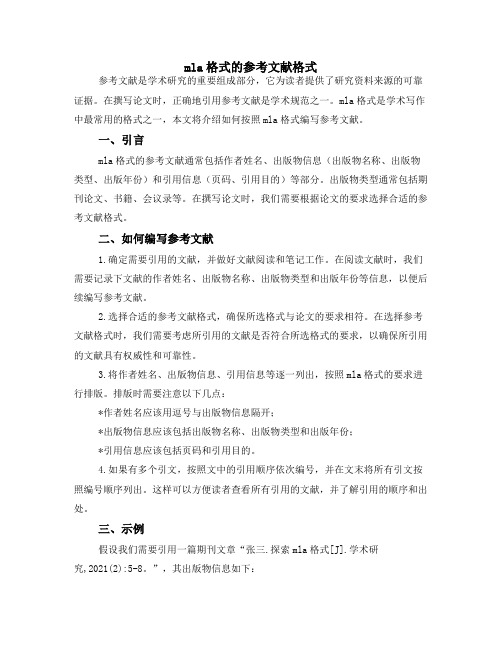
mla格式的参考文献格式参考文献是学术研究的重要组成部分,它为读者提供了研究资料来源的可靠证据。
在撰写论文时,正确地引用参考文献是学术规范之一。
mla格式是学术写作中最常用的格式之一,本文将介绍如何按照mla格式编写参考文献。
一、引言mla格式的参考文献通常包括作者姓名、出版物信息(出版物名称、出版物类型、出版年份)和引用信息(页码、引用目的)等部分。
出版物类型通常包括期刊论文、书籍、会议录等。
在撰写论文时,我们需要根据论文的要求选择合适的参考文献格式。
二、如何编写参考文献1.确定需要引用的文献,并做好文献阅读和笔记工作。
在阅读文献时,我们需要记录下文献的作者姓名、出版物名称、出版物类型和出版年份等信息,以便后续编写参考文献。
2.选择合适的参考文献格式,确保所选格式与论文的要求相符。
在选择参考文献格式时,我们需要考虑所引用的文献是否符合所选格式的要求,以确保所引用的文献具有权威性和可靠性。
3.将作者姓名、出版物信息、引用信息等逐一列出,按照mla格式的要求进行排版。
排版时需要注意以下几点:*作者姓名应该用逗号与出版物信息隔开;*出版物信息应该包括出版物名称、出版物类型和出版年份;*引用信息应该包括页码和引用目的。
4.如果有多个引文,按照文中的引用顺序依次编号,并在文末将所有引文按照编号顺序列出。
这样可以方便读者查看所有引用的文献,并了解引用的顺序和出处。
三、示例假设我们需要引用一篇期刊文章“张三.探索mla格式[J].学术研究,2021(2):5-8。
”,其出版物信息如下:*出版物名称:学术研究*出版物类型:期刊*出版年份:2021接下来,我们按照mla格式的要求进行排版,得出以下参考文献:[1]张三.探索mla格式[J].学术研究,2021(2):5-8.引用此文献时,我们需要在文中的相应位置标注“[1]”作为标识。
四、注意事项1.确保所引用的文献具有权威性和可靠性。
在选择参考文献时,我们需要认真筛选,避免引用不可靠或不真实的文献。
MLA文献条目的著录格式及示例摘要
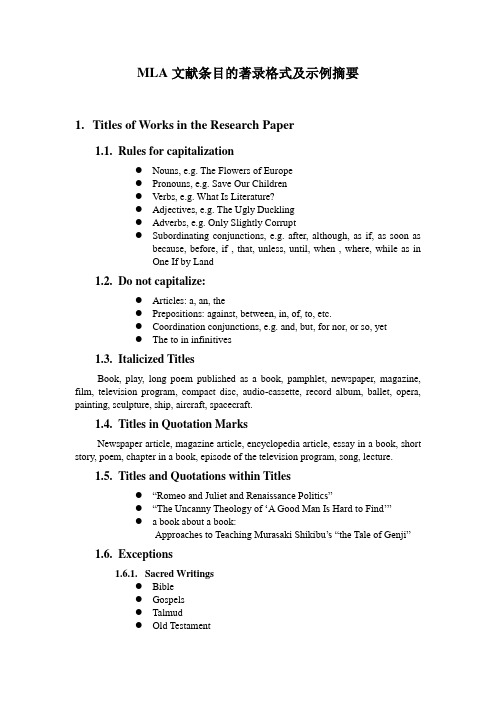
MLA文献条目的著录格式及示例摘要1.Titles of Works in the Research Paper1.1. Rules for capitalization●Nouns, e.g. The Flowers of Europe●Pronouns, e.g. Save Our Children●Verbs, e.g. What Is Literature?●Adjectives, e.g. The Ugly Duckling●Adverbs, e.g. Only Slightly Corrupt●Subordinating conjunctions, e.g. after, although, as if, as soon asbecause, before, if , that, unless, until, when , where, while as inOne If by Land1.2. Do not capitalize:●Articles: a, an, the●Prepositions: against, between, in, of, to, etc.●Coordination conjunctions, e.g. and, but, for nor, or so, yet●The to in infinitives1.3. Italicized TitlesBook, play, long poem published as a book, pamphlet, newspaper, magazine, film, television program, compact disc, audio-cassette, record album, ballet, opera, painting, sculpture, ship, aircraft, spacecraft.1.4. Titles in Quotation MarksNewspaper article, magazine article, encyclopedia article, essay in a book, short story, poem, chapter in a book, episode of the television program, song, lecture.1.5. Titles and Quotations within Titles●“Romeo and Juliet and Renaissance Politics”●“The Uncanny Theology of …A Good Man Is Hard to Find‟”● a book about a book:Approaches to Teaching Murasaki Shikibu‟s “the Tale of Genji”1.6. Exceptions1.6.1.Sacred Writings●Bible●Gospels●Talmud●Old Testament●Genesis, etc.1.6.ws, Acts, and Similar Political Documents●Declaration of Independence●Bill of Rights●Treaty of Trianon, etc.1.6.3.Series●Bollingen Series●Masterpiece Theatre2.MLA Documentation Style2.1. Bibliography2.1.1. Placement of Bibliography●end of the paper●on a new page●continuing the page numbers of the text.2.1.2. Format of Bibliography●center the title, Bibliography, an inch from the top of the page,double-space between the title and the first entry●if an entry runs more than one line, indent the subsequent linesfive spaces from the left margin● 1.5 space2.1.3. Arrangement of Entries●alphabetize entries by the author‟s last name, using theletter-by-letter system2.2. Parenthetical Documentation 夹注的格式2.2.1. Basic Formate.g.Close to each quotation or reference appears a parenthetical note which "contains only enough information to enable readers to find the source in the works-cited list" (Gibaldi 105).2.2.2. Citing Two or More Works by the Same Author of AuthorsIn a parenthetical reference to one of two or more works by the same author, put a comma after the author‟s last name and add the title of the work (if brief) or a shortened version and the relent page reference, for example, “(Frye, Double Vision 85)” or “ (Durant and Durant, Age 214-48).”2.3 Format of Entries2.3.1 Basic Entry●Sequence Number (1 2 3 4 )●Author's Last name, Author's First name.●Title of Document. (italic for books & quotation marks for theses)●Title of Complete Work (if applicable).●Name of editor (last name +first name+ ed).●Edition (if applicable).●V olume number.●Series name.●Place of publication. (+colon)●Name of publisher.●Date of publication.1. Gibaldi, Joseph. MLA Handbook for Writers of Research Papers. 4th Ed. NewYork: MLA, 1995.2. 4. Other Entries2.4.1. Book by two or more authors1. Huppé, Bernard F., and Jack Kaminsky. Logic and Language. New York: Alfred A.Knopf, 1957.2.4.2. Two or more books by the same author1. Brontë, Charlotte. Jane Eyre. Middlesex: Penguin, 1966.---.Shirley. Middlesex: Penguin, 1983.(用三个连接符代替作者姓名)2.4.3. Book in a series1. Ngugi, James. Weep Not, Child. African Writers Series. 7.London: HeinemannEducational Books, 1964.2.4.4. Introduction, Preface, Foreword, or Afterword of a book1. Pottle, Frederick A. Introduction. Boswell in Holland, 1763-1764. By James Boswell.Ed. Frederick A. Pottle. Yale Edition of the Private Papers of James Boswell.London: Heinemann, 1952.2.4.5. Multivolume works1. Grant, Robert M. "Gnosticism." Dictionary of the History of Ideas.Ed. Philip P.Wiener. V ol. 2. New York: Charles Scribner's Sons, 1973.2.4.6. Translation1. Lessing, G. E. Nathan the Wise. Trans. R. Dillon Boylan. Lessing's Dramatic Works.Ed. Ernest Bell. London: George Bell, 1878.2.4.7. Article in a periodical1. Hamblin, Robert. "'A Fine Loud Grabble and Snatch of AAA and WPA': Faulkner,Government, and the Individual." Arkansas Review: A Journal of Delta Studies31.1 (2000).2.4.8. Article in a newspaper1. Picard, André. "BC Premier's Intake Estimated at 10 Drinks." Globe and Mail[Toronto] 14 Jan. 2003: A1.2.4.9. Electric Sources / WWW (World Wide Web) documentsTo cite World Wide Web documents, provide the author's name;the title of the document; the document date; the sponsoring organization or institution; the date of access; and the full http address.1. Spacek, Richard. "Stress." 1997. The UNB Writing and Study Skills Centre On-line.15 Jan. 2001. <http://www.unb.ca/coned/wss/stress.htm>.国标《文后参考文献著录规则》(GB/T 7714—2005)著录项目、著录格式及示例摘要1.常用文献类型和载体类型标识如下:1)文献类型M——专著,C——论文集,N——报纸文章,J——期刊文章,D——学位论文,R——报告,S——标准,P——专利;对于不属于上述的文献类型,采用字母“Z”标识。
MLA简单参考格式
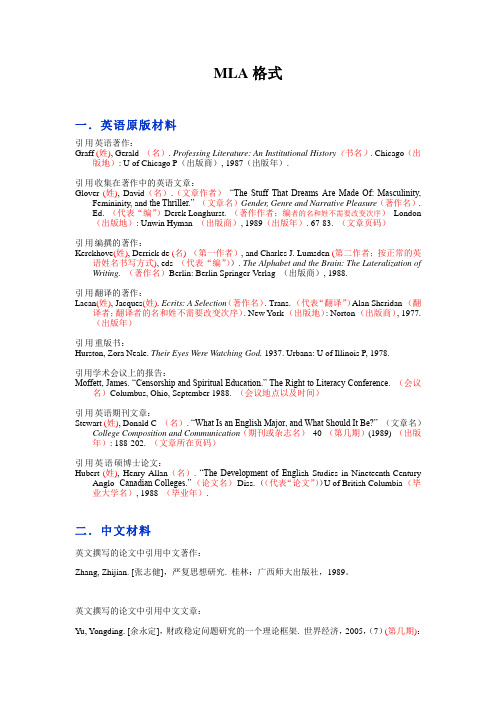
MLA格式一.英语原版材料引用英语著作:Graff (姓), Gerald (名). Professing Literature: An Institutional History(书名). Chicago(出版地): U of Chicago P(出版商), 1987(出版年).引用收集在著作中的英语文章:Glover (姓), David(名).(文章作者)“The Stuff That Dreams Are Made Of: Masculinity, Femininity, and the Thriller.” (文章名)Gender, Genre and Narrative Pleasure(著作名).Ed. (代表“编”)Derek Longhurst. (著作作者;编者的名和姓不需要改变次序)London (出版地): Unwin Hyman (出版商), 1989(出版年). 67-83. (文章页码)引用编撰的著作:Kerckhove(姓), Derrick de (名) (第一作者), and Charles J. Lumsden (第二作者;按正常的英语姓名书写方式), eds (代表“编”)). The Alphabet and the Brain: The Lateralization of Writing. (著作名)Berlin: Berlin Springer-Verlag (出版商), 1988.引用翻译的著作:Lacan(姓), Jacques(姓). Ecrits: A Selection(著作名). Trans. (代表“翻译”)Alan Sheridan (翻译者;翻译者的名和姓不需要改变次序). New York (出版地): Norton (出版商), 1977.(出版年)引用重版书:Hurston, Zora Neale. Their Eyes Were Watching God. 1937. Urbana: U of Illinois P, 1978.引用学术会议上的报告:Moffett, James. “Censorship and Spiritual Education.” The Right to Literacy Conference. (会议名)Columbus, Ohio, September 1988. (会议地点以及时间)引用英语期刊文章:Stewart (姓), Donald C (名). “What Is an English Major, and What Should It Be?” (文章名)College Composition and Communication(期刊或杂志名)40 (第几期)(1989) (出版年): 188-202. (文章所在页码)引用英语硕博士论文:Hubert (姓), Henry Allan(名). “The Development of Engl ish Studies in Nineteenth-Century Anglo- Canadian Colleges.” (论文名)Diss. ((代表“论文”))U of British Columbia (毕业大学名), 1988 (毕业年).二.中文材料英文撰写的论文中引用中文著作:Zhang, Zhijian. [张志健],严复思想研究. 桂林:广西师大出版社,1989。
论文MLA格式详解(参考)

论文MLA格式详解论文MLA格式详解因为学术论文的格式有严谨要求,所以也找了相关资料。
下面是我搜集整理的的针对MLA格式最详细的解说,还有举例。
MLA论文的如果句子中已经提供了作者的信息两个或三个作者,要写出每一个作者的姓:三个作者以上,可以写出每一个作者的姓,或者只写出第一个作者的姓,用 et al. 代替其余作者。
如果参考文献同一个作者的不同著作,要在作者的姓后面注明著作名称,再加页码:机构作者,用机构的全称或缩写形式:匿名作者,用文章题目的几个单词:begin s to imp ossibl s hine thr ough.以下是与文内注释相对应的论文末尾的参考文献条目:Warhol,And. Th e Philos oph of A nd Warho l. Ne Yo rk: Haro urt Brae, 1975.3. 引用文学作品小说的注释,除了页码外,最好还加上卷、章,页码后用分号。
长诗的注释要分卷、行。
戏剧的注释应标出引文的幕、场、行。
范例:如果没理由确定作者,则用书名。
文学作品的引文如果超过4行,则需要上下各空一行另成一段,第一行不缩进,英文每一行左边都缩进10个字符,中文空四格,不用引号,右边不缩进。
范例:Natureis not s impl the Not-Mebut also the uni versal m ind hose signs a re visib le for t he indiv idualt o read,ith ees, heart a nd mind.Ever m an s ond ition is a solut ion in h ieroglph i to tho se inqui ries heould put.He at s it a l ife befo re he ap prehends it as t ruth. In like ma nner,nat ure is a lread, i n its fo rms andtendenie s, desri bing its on desi gn. Letus inter rogate t he great apparit ion that shinesso peaef ull arou nd us. T hat theindividu al soulan beet he mediu m of the divinefores of Natureis at th e heartof thisbook.如果在正文里引用的诗歌为两行以上,除了引号外,每一行诗还须用左斜线分隔。
MLA 正文引用+参考文献教学提纲

M L A正文引用+参考文献正文内文献引用的MLA格式要求(1)一件作品或多件作品的引用:●It has been argued that teachers’ role is to provide the students with optimalconditions which can facilitate learning so that students can achieve similarsuccessful results (Bloom 12-6).●Gagne (38-41) also noticed that adult learners were less affected by externalinstruction events.●The advantage of the multiple regression analysis is that it cannot show thecomplex interrelations between independent variables (Bryman and Crammer 135-9).●Studies of the good language learner (for example, Naiman et al. 49-52) havetried to identify the strategies which successful learners use (Ellis 37).●Naiman et al. (49-52) found a similar relationship, although in this case ‘effort’on the part of the learners was also associated with instrumental motivation(Ellis 512).(注意:MLA格式不加年代,只加作者姓和页码,没有逗号)(2)同一括号里多件作品的引用:●Empirical studies on student learning carried out since the 70’s have found thatstudents’ learning outcomes to a great extent depend on their choice of learning(注意:这里的下划线表示作者的两篇不同作品,我们现在统一用斜体代替下划线)●The major finding from the earlier studies (Barley; Clement et al.; Gardner andLambert; Gliksman; Spolsky) was that learners with an integrative motivation tended to obtain better achievement that those with an instrumental motivation.(注意引用作品的排序)●In The Age of Voltaire, the Durants portray eighteenth century England as aminor force in the world of music and art (214-48).(注意:文内已出现作者名,括号里就只要加页码)(请认真对照附件2)附件2:参考文献MLA格式要求●按先英文后中文排序;●字号比正文小一号打印;标点统一用半角状态;标点后统一空一格(汉语文献与英语文献类同,见下面示例);●悬挂缩进;●书目格式按MLA格式排列。
7. MLA(撰写补充规定里提到过的引用参考书目格式)

MLA引用文献的规范1.引用书籍和其他非杂志类的出版物1)一个作者,一本著作(A Book by a Single Author)这是学术论文中引用最多的一种形式,包括三个主要部分:Author’s name. Title of the book. Publication information.作者姓名. 书名. 出版信息例如:Wilson, Frank R. The Hand: How Its Use Shapes the Brain, Language, and Human Culture. New York: Pantheon, 1998.作者姓名(Author’s Name)将作者的姓放在前,名在后,中间用逗号隔开,全名后再用句号。
Wilson, Frank R.Porter, Katherine Anne.在引用作品中,作者姓名应与所引用的书名或文章中一致,不能将其名字缩写,如书籍中的作者名字是George Brown,在引用作品中则不能写成Brown, G. 如果引用的书籍或文章中用的是缩略形式,则可沿用。
如Eliot, T. S.McLuhan, H. Marshall.作者姓名前的职称、职务或学位等,在引用作品中都应略去。
ON TITLE PAGE IN WORKS-CITED LISTAnthony T. Boyle, PhD Boyle, Anthony T.Sister Jean Daniel Daniel, Jean.Sir Philip Sidney Sidney, Philip.书名(Title of the Book)通常,所引用的书名应用全称,包括副标题在内。
如果有副标题,则在书名后加冒号(colon),当然,书名是末尾是问号、感叹号或破折号时除外。
书名全称(包括副标题)后加句号(period),如书名的结尾有另一个标点符号除外。
书名全称,包括冒号、副标题和书名中的标点符号都加下划线,但书名全称后的句号不能加下划线。
MLA格式参考文献示例

MLA格式参考文献示例期刊文章1. 一位作者写的文章Stewart, Donald C. "What is an English Major, and What Should It be?" College Composition and Communication 40 (1989): 188-202.Yu, Yongding. [余永定]. 财政稳定问题研究的一个理论框架. 世界经济, 2005 (7): 25-29.2. 两位作者写的文章Brownell, Hiram H., and Heather H. Potter. "Inference Deficits in Right-Brain Damaged Patients." Brain and Language 27 (1986): 310-21.Li, Jianzhong, and Liu, Xianmin. [李建中, 刘显敏]. 大数据的一个重要方面:数据可用性. 计算机研究与发展, 2013 (6): 1147-62.3. 三位及以上的作者写的文章Mascia-Lees, Frances E., et al. "Double Liminality and the Black Woman Writer."American Behavioral Scientist 31 (1987): 101-14.Zhang, Peng, et al. [张鹏等]. 云计算环境下适于工作流的数据布局方法. 计算机研究与发展, 2013 (3): 636-47.专著1.一位作者写的书籍Graff, Gerald. Professing Literature: An Institutional History. Chicago: U of Chicago P, 1987.Zhang, Zhijian. [张志健]. 严复思想研究. 桂林: 广西师大出版社, 1989.2.两位作者写的书籍Plant, Raymond, and Kenneth Hoover. Conservative Capitalism in Britain and the United States: A Critical Appraisal. London: Routledge, 2014.Yin, Di, and Shang, Hai. [隐地, 尚海]. 到绿光咖啡屋听巴赫读余秋雨. 上海: 上海世界图书出版公司, 2001.3.三位作者写的书籍Chen, Weizheng, et al. [陈维政等]. 人力资源管理. 大连: 大连理大学出版社, 2006.Hall, Stuart, et al. Culture, Media, Language: Working Papers in Cultural Studies, 1972-79 (Cultural Studies Birmingham). London: Routledge, 1991.4. 新版书Erikson, Erik. Childhood and Society. 2nd ed. New York: Norton, 1963.编著1. 一位主编编撰的书籍Loshin, David, ed. Big Data Analytics. Boston: Morgan Kaufmann, 2013.Zhong, Lanfeng. [钟兰凤] (编). 英文科技学术话语研究. 镇江: 江苏大学出版社, 2014.2. 两位主编编撰的书籍Kerckhove, Derrick De, and Charles J. Lumsden, eds. The Alphabet and the Brain: The Lateralization of Writing. Berlin: Springer-Verlag, 1988.Zhang, Delu, and Zhang, Guo. [张德禄, 张国] (编). 英语文体学教程. 北京: 高等教育出版社, 2011.3. 三位及以上主编编撰的书籍Campbell, Colin. M., et al, eds. Groups St Andrews 2001 in Oxford: Volume 2. New York: Cambridge UP, 2003.Zhang, Keding, et al. [张克定等] (编). 系统评价功能. 北京: 高等教育出版社, 2007.4. 书中的文章Glover, David. "The Stuff that Dreams are Made of: Masculinity, Femininity, and the Thriller." Gender, Genre and Narrative Pleasure. Ed. Derek Longhurst. London: Unwin Hyman, 1989. 67-83.He, Jianmin, and Yu, Jianping. [何建敏, 于建平]. 学术论文引言部分的经验功能分析. 张克定等(编). 系统功能评价. 北京: 高等教育出版社, 2007, 93-101.Miao, Xingwei. [苗兴伟]. 英语的评价型强势主位结构. 张克定, 王振华(编). 系统功能评价. 北京: 高等教育出版社, 2007, 163-69.翻译的书籍(Translated book)Lacan, Jacques. Ecrits: A Selection. Trans. Alan Sheridan. New York: Norton, 1977. Le, Dailei. [勒代雷]. 释意学派口笔译理论. (刘和平译). 北京: 中国对外翻译出版公司, 2001.Kontra, Miklos, et al. 语言: 权利和资源. (李君, 满文静译). 北京: 外语教学与研究出版社, 2014.Wang, Rending, and Yu, Qiuyu. [王仁定, 余秋雨]. 吴越之间——余秋雨眼里的中国文化(彩图本). (梁实秋, 董乐天译). 上海: 上海文化出版社, 2001.硕博士论文Hubert, Henry Allan. "The Development of English Studies in Nineteenth-Century Anglo- Canadian Colleges." Diss. U of British Columbia, 1988.Wang, Xuanzi. [王璇子]. 功能对等视角下的英语长句翻译. 南京大学硕士学位论文, 2014.注:1.出版社名称须使用缩写。
- 1、下载文档前请自行甄别文档内容的完整性,平台不提供额外的编辑、内容补充、找答案等附加服务。
- 2、"仅部分预览"的文档,不可在线预览部分如存在完整性等问题,可反馈申请退款(可完整预览的文档不适用该条件!)。
- 3、如文档侵犯您的权益,请联系客服反馈,我们会尽快为您处理(人工客服工作时间:9:00-18:30)。
MLA文献条目的著录格式及示例摘要1.Titles of Works in the Research Paper1.1. Rules for capitalization●Nouns, e.g. The Flowers of Europe●Pronouns, e.g. Save Our Children●Verbs, e.g. What Is Literature?●Adjectives, e.g. The Ugly Duckling●Adverbs, e.g. Only Slightly Corrupt●Subordinating conjunctions, e.g. after, although, as if, as soon asbecause, before, if , that, unless, until, when , where, while as inOne If by Land1.2. Do not capitalize:●Articles: a, an, the●Prepositions: against, between, in, of, to, etc.●Coordination conjunctions, e.g. and, but, for nor, or so, yet●The to in infinitives1.3. Italicized TitlesBook, play, long poem published as a book, pamphlet, newspaper, magazine, film, television program, compact disc, audio-cassette, record album, ballet, opera, painting, sculpture, ship, aircraft, spacecraft.1.4. Titles in Quotation MarksNewspaper article, magazine article, encyclopedia article, essay in a book, short story, poem, chapter in a book, episode of the television program, song, lecture.1.5. Titles and Quotations within Titles●“Romeo and Juliet and Renaissance Politics”●“The Uncanny Theology of …A Good Man Is Hard to Find‟”● a book about a book:Approaches to Teaching Murasaki Shikibu‟s “the Tale of Genji”1.6. Exceptions1.6.1.Sacred Writings●Bible●Gospels●Talmud●Old Testament●Genesis, etc.1.6.ws, Acts, and Similar Political Documents●Declaration of Independence●Bill of Rights●Treaty of Trianon, etc.1.6.3.Series●Bollingen Series●Masterpiece Theatre2.MLA Documentation Style2.1. Bibliography2.1.1. Placement of Bibliography●end of the paper●on a new page●continuing the page numbers of the text.2.1.2. Format of Bibliography●center the title, Bibliography, an inch from the top of the page,double-space between the title and the first entry●if an entry runs more than one line, indent the subsequent linesfive spaces from the left margin● 1.5 space2.1.3. Arrangement of Entries●alphabetize entries by the author‟s last name, using theletter-by-letter system2.2. Parenthetical Documentation 夹注的格式2.2.1. Basic Formate.g.Close to each quotation or reference appears a parenthetical note which "contains only enough information to enable readers to find the source in the works-cited list" (Gibaldi 105).2.2.2. Citing Two or More Works by the Same Author of AuthorsIn a parenthetical reference to one of two or more works by the same author, put a comma after the author‟s last name and add the title of the work (if brief) or a shortened version and the relent page reference, for example, “(Frye, Double Vision 85)” or “ (Durant and Durant, Age 214-48).”2.3 Format of Entries2.3.1 Basic Entry●Sequence Number (1 2 3 4 )●Author's Last name, Author's First name.●Title of Document. (italic for books & quotation marks for theses)●Title of Complete Work (if applicable).●Name of editor (last name +first name+ ed).●Edition (if applicable).●V olume number.●Series name.●Place of publication. (+colon)●Name of publisher.●Date of publication.1. Gibaldi, Joseph. MLA Handbook for Writers of Research Papers. 4th Ed. NewYork: MLA, 1995.2. 4. Other Entries2.4.1. Book by two or more authors1. Huppé, Bernard F., and Jack Kaminsky. Logic and Language. New York: Alfred A.Knopf, 1957.2.4.2. Two or more books by the same author1. Brontë, Charlotte. Jane Eyre. Middlesex: Penguin, 1966.---.Shirley. Middlesex: Penguin, 1983.(用三个连接符代替作者姓名)2.4.3. Book in a series1. Ngugi, James. Weep Not, Child. African Writers Series. 7.London: HeinemannEducational Books, 1964.2.4.4. Introduction, Preface, Foreword, or Afterword of a book1. Pottle, Frederick A. Introduction. Boswell in Holland, 1763-1764. By James Boswell.Ed. Frederick A. Pottle. Yale Edition of the Private Papers of James Boswell.London: Heinemann, 1952.2.4.5. Multivolume works1. Grant, Robert M. "Gnosticism." Dictionary of the History of Ideas.Ed. Philip P.Wiener. V ol. 2. New York: Charles Scribner's Sons, 1973.2.4.6. Translation1. Lessing, G. E. Nathan the Wise. Trans. R. Dillon Boylan. Lessing's Dramatic Works.Ed. Ernest Bell. London: George Bell, 1878.2.4.7. Article in a periodical1. Hamblin, Robert. "'A Fine Loud Grabble and Snatch of AAA and WPA': Faulkner,Government, and the Individual." Arkansas Review: A Journal of Delta Studies31.1 (2000).2.4.8. Article in a newspaper1. Picard, André. "BC Premier's Intake Estimated at 10 Drinks." Globe and Mail[Toronto] 14 Jan. 2003: A1.2.4.9. Electric Sources / WWW (World Wide Web) documentsTo cite World Wide Web documents, provide the author's name;the title of the document; the document date; the sponsoring organization or institution; the date of access; and the full http address.1. Spacek, Richard. "Stress." 1997. The UNB Writing and Study Skills Centre On-line.15 Jan. 2001. <http://www.unb.ca/coned/wss/stress.htm>.国标《文后参考文献著录规则》(GB/T 7714—2005)著录项目、著录格式及示例摘要1.常用文献类型和载体类型标识如下:1)文献类型M——专著,C——论文集,N——报纸文章,J——期刊文章,D——学位论文,R——报告,S——标准,P——专利;对于不属于上述的文献类型,采用字母“Z”标识。
